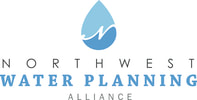|
The need to protect source water is growing exponentially as drinking water supplies throughout the NWPA region continue to be threatened by water quality and quantity constraints. Population growth and the depletion of the sandstone aquifers are pressuring many communities to rely more heavily on shallow aquifers or turn to a different water source entirely. However, these sources also have their share of complications. Shallow aquifers are vulnerable to contamination given their proximity to the land’s surface. At the same time, dry spells and drought conditions diminish supply in shallow aquifers and rivers. Weather trends like these will likely be more prevalent as climate change upends the region, making these sources less reliable into the future. In response to this need for improved protection, state legislation was passed in July 2019 requiring that community water suppliers (CWSs) develop a source water protection plan (SWPP) – a plan aimed at advancing the protection of the water quality and quantity at the community level. In an effort to better coordinate and conserve the region’s water resources, this type of plan can help a community protect its source water. Source Water Protection Plans 101 Each SWPP must contain at minimum four specific elements: a vision statement, a source water assessment, plan objectives, and an action plan to meet the plan’s objectives (see Ill. Admin. Code tit. 35, § 604.305).
Leveraging SWPPs in the NWPA region While SWPPs are a requirement for all CWSs, communities should view their plan—more specifically the planning process—as an opportunity to comprehensively address the community’s source water protection challenges. In addition to the baseline requirements, CWSs could assess existing water conservation efforts in search for opportunities to ‘protect’ source water by simply using less, whether that be through reducing outdoor water use or water efficiency measures. Similarly, CWSs can assess the community’s future land use as well as projected water demand relative to the community’s water supply to better understand future challenges and potential options. Like many planning processes, stakeholder engagement and community support and buy-in are key to plan implementation. This holds true for SWPPs as well. Recognizing that CWSs are not the only actor vested in source water protection, the SWPP planning process can help CWSs improve coordination and align efforts as they identify stakeholders, engage with the public, and learn about other existing source water protection efforts within the CWS service area. Soil and water conservation districts, chambers of commerce, and local watershed planning groups are a few entities, for example, that may have a role in helping implement a CWS’s SWPP action plan. Aurora, Elgin, and Sugar Grove are a few NWPA communities that are in the process of developing a SWPP that goes beyond the minimum requirements. These CWSs can serve as a resource to other communities that are interested in learning about the planning process and how to approach the SWPP development more comprehensively. Elgin, for instance, is focusing on stakeholder and community engagement to give the CWS an opportunity to take advantage of existing protection efforts already underway and garner community support to minimize barriers to plan implementation. Sugar Grove's SWPP provides a thorough assessment of water quality impacts, including a detailed overview of their wellhead protection areas and evaluating potential sources of contamination based on point sources and the existing land uses within the community. Resources for preparing SWPPs There are a variety of resources that can help CWSs get started on their SWPP! Back in the early 2000s, the Illinois EPA developed Community Water Supply Source Water Assessment Program Factsheets. These function as a great starting point for a CWS as it develops its source water assessment. The Illinois EPA also an interactive map with a series of datasets than can also help with preparing the assessment. Upon request, a CWS can seek technical assistance for the Illinois EPA to help develop their source water assessment. Communities can simply use the factsheets, albeit outdated, to fulfill their assessment requirement as well. In addition to IEPA resources, the NWPA has numerous resources that can help a community prepare a SWPP. They have a repository of the latest studies and data on drinking water supplies in northeastern Illinois as well as tools to assist with source water protection and promote best management practices in outdoor water use, sensible salting, and water conservation. The American Water Works Association’s (AWWA) also has a Source Water Protection Operational Guide which is an easy-to-read guide that can help CWSs walk through the SWPP planning process and create an effective plan. IL AWWA even has source water protection committee that can serve a resource as CWSs prepare their SWPP. |
ABOUTThe latest updates page features posts about issues affecting NWPA member communities and best practices, drawing on interviews and conversations with experts. Archives
July 2024
Categories
All
|
